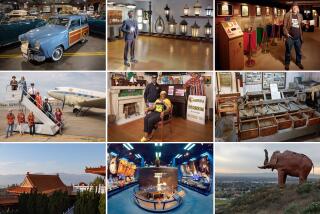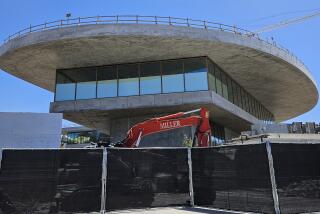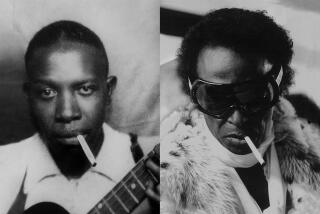A museum that’ll stay in move-in condition
- Share via
FRED WEISMAN couldn’t help it. He just had to buy all that art and stuff it into his house and gardens.
During a decade of residence at his Mediterranean-style estate in Holmby Hills, he put Modern classics in the living room, Surrealist paintings in the dining room and an eclectic array of high-spirited contemporary art everywhere else.
A giant cat by Fernando Botero stands by the swimming pool. Pop paintings by Roy Lichtenstein grace the lanai. A sculpture of a sexy nude woman by John d’Andrea perches on a bedroom sofa. Startlingly realistic life-size figures by Duane Hanson -- a woman with a vacuum cleaner, a dozing old man and likenesses of Weisman’s parents -- pop up in various settings. Even the mailbox is a work of art, a sculpture of a hand and forearm by Frank Fleming.
When Weisman ran out of space, he covered windows, mounted paintings on ceilings and built a spacious modern annex to display more art. At his death in 1994, he had amassed a 1,500-piece collection and installed about 500 of those objects in and around his home.
The point of collecting art, Weisman thought, was to enjoy it, live with it and share it -- forever. His will decreed that the art-filled property be kept intact and maintained as a museum.
“He wanted this to be an example of living with art in the late 20th century,” says his second wife, art conservator Billie Milam Weisman. She directs the Frederick R. Weisman Art Foundation, overseeing the art holdings and lending works to museums worldwide. At the moment, a Weisman painting by Belgian Surrealist Rene Magritte is on view at the Los Angeles County Museum of Art and a 125-piece show from the collection is at the Contemporary Arts Center in New Orleans.
Many people have seen the fruits of Weisman’s collecting, at his house and elsewhere -- the foundation has quietly conducted tours of the highly unusual estate since his death. But now Weisman’s wish is an officially sanctioned reality. The foundation has the approval of the Los Angeles City Planning Commission to operate the house as a museum in a single-family residential neighborhood.
“Fred thought people were intimidated by art in museums, but less so when it is in homes,” Billie Weisman says. “We are making Fred proud by continuing to operate the way he wanted it.”
The museum is open free, by appointment only, Mondays through Fridays, 10 a.m. to 4 p.m. The first tour begins at 10:30 a.m., the last one at 2 p.m. Operating on a highly restricted basis, the foundation is prohibited from publishing its address or street name. Prospective visitors gain access by making reservations via e-mail at [email protected] or by telephone (310) 277-5321. Guests must park their cars inside the walled compound.
Fortunate turn of events
THE job of turning the Weisman estate into a museum fell to attorney Elizabeth Watson of Greenberg Glusker LLP. The impetus was a complaint to the city Department of Building and Safety from an unidentified neighbor, Watson says. When city officials followed up with a visit to the house, they informed the foundation that it must stop operating the museum or get the necessary approval.
“What’s fortunate in this case is that the city of Los Angeles actually has a very special provision for what they call ‘public benefit projects,’ ” Watson says. “It hasn’t been in place very long, and it’s been used primarily for city projects, municipal buildings. We utilized that section of the code which allows public benefit projects like museums and libraries in any zone in the city if you meet certain requirements. It allows the city to impose special conditions to be sure the use is compatible with the neighborhood.
“The other aspect that worked strongly in our favor,” she says, “was that the foundation was using an existing single-family home, so the appearance of the building and grounds are entirely consistent with the neighborhood. We weren’t building something that looked different. And, of course, that’s really the essence of the Weisman museum. It’s first and foremost a single-family estate. The core mission of the foundation -- to preserve Fred Weisman’s home as he lived in it with his art -- was very consistent with the values in the city zoning code.”
Nonetheless, the approval process took about a year to complete. The foundation needed discretionary special approvals from the city, including a public benefit project approval and variances on parking and the height of the wall and hedge along the front of the property.
Watson also worked with the foundation to get community support, including an endorsement from the Bel Air-Beverly Crest Neighborhood Council, and negotiated operating conditions with abutting neighbors.
Steve Twining, president of the council, says the museum got the group’s enthusiastic support.
“I think it’s a cultural treasure,” he says. “We wouldn’t be thrilled to have a museum on every block, but because of the precise situation and parking restrictions, I don’t see it as a disruption. I didn’t hear any objections.”
“The irony to all this,” Watson says, “is that this museum has got to be the most popular neighbor in this area. If you have a single-family estate next door, you can have any number of events, any number of visitors, any number of staff. Who wouldn’t want a neighbor that doesn’t have anything happening on weekends except for occasional events?”
The foundation is allowed to conduct weekend tours only one day a month and to hold a maximum of eight special events a year, six of which may run past 7 p.m. The number of visitors per day must not exceed 90 and daily on-site staff is limited to 20. Attendance at special events is capped at 150 guests except for one event each year that can have up to 250.
The regulations don’t signify much change. They essentially formalize operating conditions that the foundation had imposed on itself, Watson says.
Carving out his niche
THE man who built the collection was the son of Russian immigrants. Born in Minneapolis in 1912, he moved to California as a child. Weisman was involved in dozens of business ventures but made the bulk of his fortune as head of Mid-Atlantic Toyota Distributors.
He began collecting art in the 1950s with his first wife, Marcia Simon Weisman, the sister of industrialist Norton Simon, also a major collector. While Simon focused on French Impressionism, European Old Masters and Southeast Asian art, the Weismans concentrated on modern and contemporary works, including Surrealism, Abstract Expressionism and Pop art. The couple divorced in 1981 and divided the collection. Some works displayed at Weisman’s house are among those he retained in the settlement, but most are later acquisitions.
Shopping independently in the 1980s and early ‘90s, Weisman bought with great enthusiasm. Known for making quick decisions and snapping up the work of emerging artists as well as that of established figures, he indulged his taste for bright colors, bold statements, illusionistic tricks and cheeky humor. A sober Picasso painting of a mother and child hangs over the fireplace in the living room, but a Pop painting of a bare foot with painted toenails by Tom Wesselmann occupies a similar place in the music room. A portrait of Billie Weisman by Beau Bradford is reflected in a sort of hall of mirrors in the master bathroom.
“Fred liked uplifting art,” she says. “He liked the bright side of things.”
The collector bought the Holmby Hills house -- a 1920s creation of architect Gordon B. Kaufmann -- in 1982 and spent about 10 years filling it with art. Weisman attempted to establish a museum for his collection at Greystone Mansion in Beverly Hills in the mid-1980s. But he gave up on the plan after months of negotiations and decided to turn his home into a museum that would operate in perpetuity.
The furniture -- much of it upholstered with Weisman’s favorite flowered chintz -- remains in place, surrounded by art. The modern annex, designed by architect Frank Israel and completed in 1992, provides a sharp contrast in a high-ceilinged, wide-open space. The relatively sparse installation offers portraits of Marilyn Monroe by Andy Warhol and massive box-like sculptures by Donald Judd. In the center of the room, a life-size sculpture of a biker in a black leather jacket by Hanson stands near two motorcycles decorated by Keith Haring.
“Fred took risks in business and art,” Billie Weisman says. “He lost a few, but he won a lot.”
More to Read
The biggest entertainment stories
Get our big stories about Hollywood, film, television, music, arts, culture and more right in your inbox as soon as they publish.
You may occasionally receive promotional content from the Los Angeles Times.










